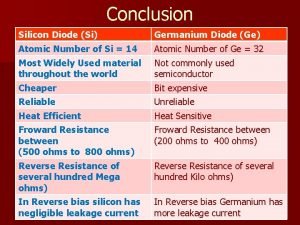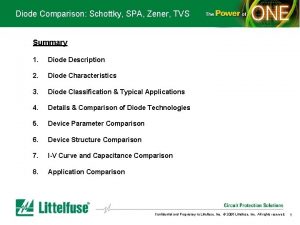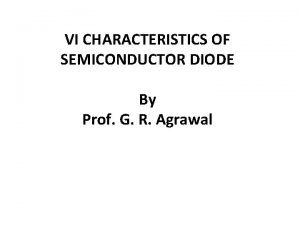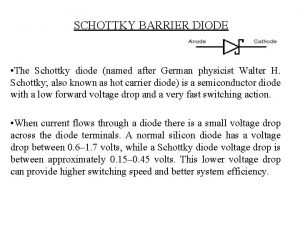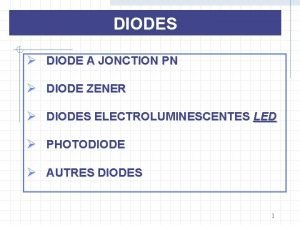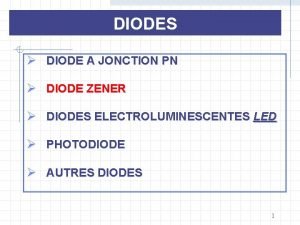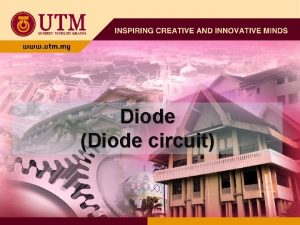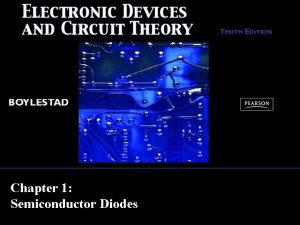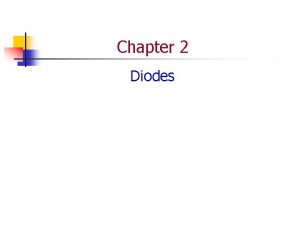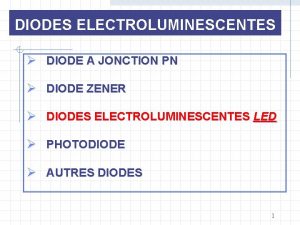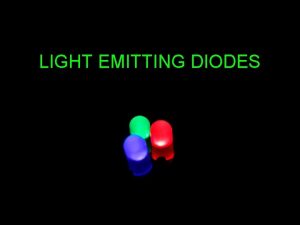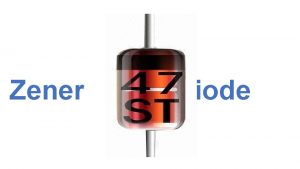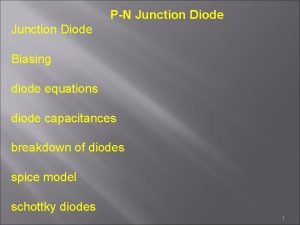Diodes AIM To understand diode characteristics To appreciate











- Slides: 11

Diodes AIM: To understand diode characteristics To appreciate what diodes are used for PRIOR KNOWLEDGE: Simple circuit rules, using resistors www. pfnicholls. com

Diode Basics A diode only allows current to flow in one direction. Circuit Symbol for a Diode The Cathode is marked with a band Two different types of diode. The top one is a signal diode that can only handle small currents A diode has two terminals called the Anode and Cathode. Current only flows from the Anode to the Cathode The 1 N 4001 Diode shown can handle currents up to 1 Amp, other diodes can handle even more current

Basic Operation The graph shows how the current through a diode depends on the potential difference across the diode In Reverse Bias the diode is backwards and no current flows through the diode When the potential difference across the diode is less than 0. 6 V no current flows When the potential difference is greater than 0. 6 V the diode conducts and current flows As the current increases, the potential difference stays almost constant at about 0. 7 V

Forward Bias When a diode is connected so that current can flow it is said to be FORWARD BIASED In the example shown: • The battery voltage is 6 V which is enough to make the diode conduct • The forward voltage drop across the diode is 0. 7 V • The potential difference across the bulb is therefore 5. 3 V • The diode will be damaged if too much current flows

Reverse Bias When a diode is connected so that NO current can flow it is said to be REVERSE BIASED In the example shown: • The battery voltage is 6 V but the diode is connected “backwards” • The reverse bias voltage drop across the diode is 6 V • The potential difference across the bulb is therefore zero – the bulb is not lit • The diode will be damaged if the reverse bias voltage is too great

Protection Diode Physics fact: When current suddenly stops flowing through a coil (called an inductive load) such as a motor, solenoid or relay then a large voltage is generated – this is called the “back EMF”. Electronics fact: The back EMF will easily damage transistors and integrated circuits that are controlling the inductive load. Solution: Add a diode in reverse bias across the inductive load (the motor in the diagram) Note: The diode protects the control circuit, not the motor

Rectification A. C. – Current flows alternately in each direction D. C. – Current only flows in one direction Because a diode only allows current to flow in one direction it can be used to convert A. C. into D. C. This process is called RECTIFICATION Note the peak voltage is 0. 7 V less than the input

Voltage Reference The input voltage can be any reasonable voltage as long as it is above 0. 7 V so that the diode conducts The output voltage will vary a bit but be about 0. 7 V When a reasonable current flows through a diode, the potential difference across the diode is approximately constant at about 0. 7 V A diode in a potential divider can provide a relatively constant reference voltage even when the supply voltage changes which is useful in comparator circuits.

Summary • Diodes only allow current to flow in one direction • Current can flow when the diode is forward biased • Current does not flow when the diode is reverse biased • When the diode is conducting and current is flowing, the potential difference across the diode is approximately 0. 7 V • Too much (forward biased) current will damage the diode • Too much (reverse biased) voltage will damage the diode • Diodes can protect semiconductor devices from the back emf produced by inductive loads • Diodes can be used to rectify A. C. signals • Diodes in a potential divider can provide a fixed reference voltage

Questions 1. What is the potential difference across a diode when it is conducting? 2. How can a diode be damaged? 3. What does rectification mean? 4. How can you tell which way round to put a diode in your circuit? 5. What does forward bias mean? 6. Why is a protection diode connected so that it is reverse biased?

Answers 1. The voltage across a diode when it is conducting is 0. 7 volts 2. A diode is damaged by too much forward current OR too much reverse voltage 3. Rectification means converting A. C. into D. C 4. You can work out which way round to put a diode in your circuit because the cathode is marked with a band 5. Forward bias means connected so that current can flow i. e. with the anode connected to the positive side of the battery 6. A protection diode is connected reverse biased so that it does not usually conduct and is therefore not part of the circuit
 To understand recursion you must understand recursion
To understand recursion you must understand recursion Aim to understand
Aim to understand Germanium diode graph
Germanium diode graph Zener tvs
Zener tvs How is zener diode different from pn junction diode
How is zener diode different from pn junction diode Hot carrier diode
Hot carrier diode Client centered therapists try to appreciate
Client centered therapists try to appreciate Appreciate art
Appreciate art They do not appreciate my singing
They do not appreciate my singing We should appreciate cherish and cultivate blessings
We should appreciate cherish and cultivate blessings Appreciate naked
Appreciate naked You
You


